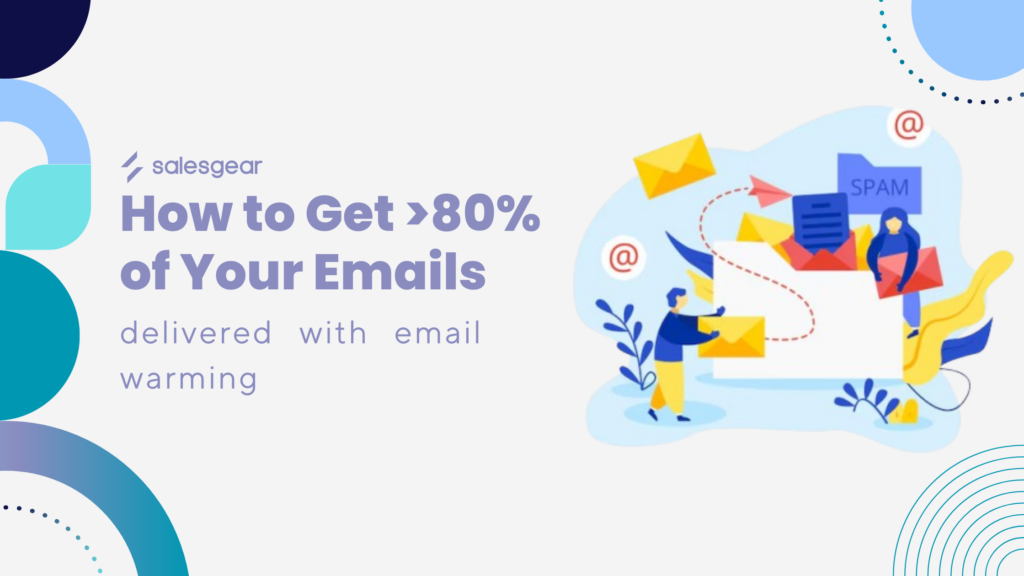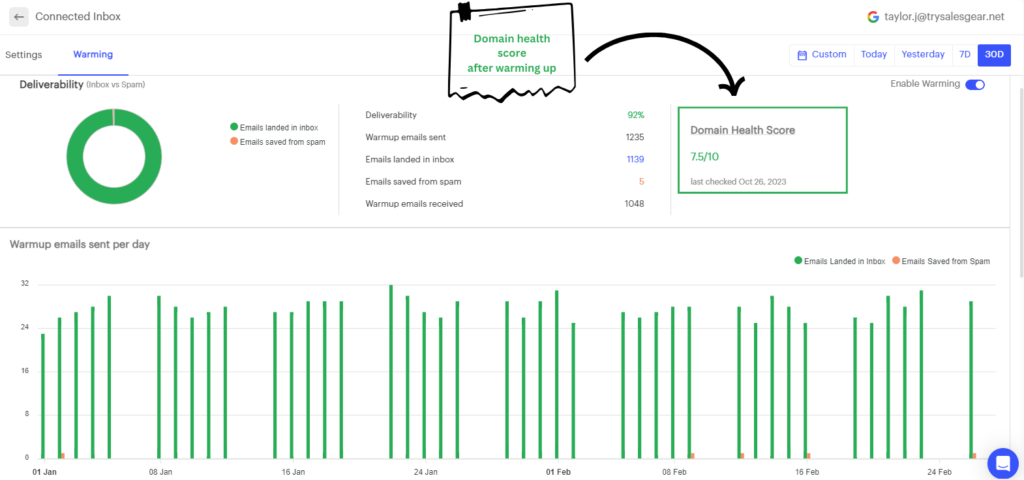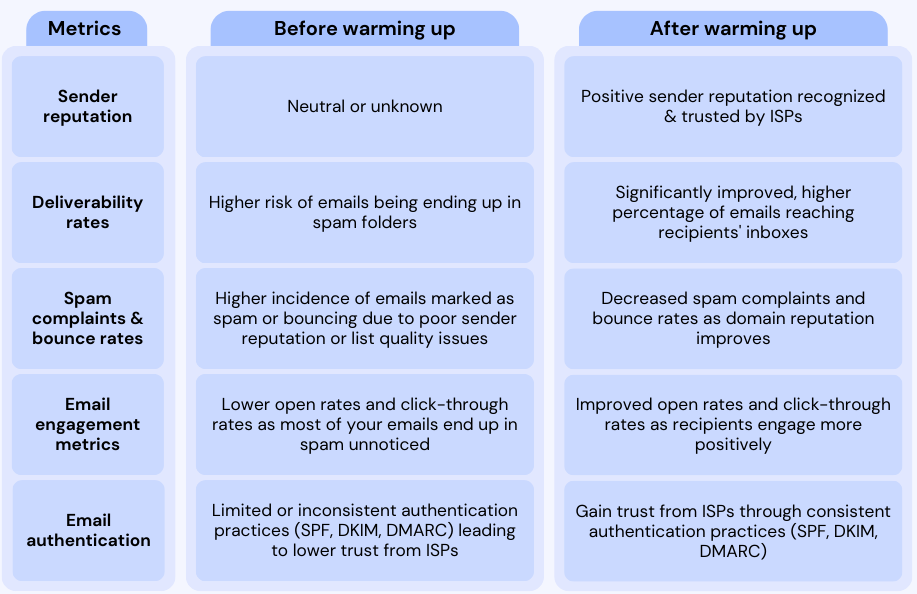
How to Get>80% of Your Emails Delivered in Inbox with Email Warming
Do you still do your ‘cold email outreach’ without proper email warming?
If yes, please don’t.
Because your killer campaigns would –
- Have neither clicks nor opens.
- Reduce your sender reputation
- Be directly sent to spam
So, what should you do?
Warm up your email account.
Email warming involves gradually increasing the sending volume from a new email account. It is to build a positive reputation with email service providers (ESPs), like Gmail or Outlook.
It’s like introducing yourself gradually to someone new rather than barging in uninvited.

Think of it as training wheels for your email outreach. It signals to ESPs that you’re a legitimate sender with engaged recipients, boosting your email deliverability.
Without proper warming, your emails will-
- Land in the spam folder. ESPs scrutinize new senders, and a sudden surge of emails can trigger spam filters.
- Not reach the intended recipients at all. Thus, reducing deliverability.
- Damage your ‘sender reputation’. Consistent low deliverability can severely harm your sender reputation. Making it harder to reach inboxes in the future.

Now, this is exactly what you don’t want, right?
Use tools like Salesgear to automate email warmup. And, track the same 24/7 with ‘domain health score’.
Think of your domain health score like your credit score for email marketing. A low score indicates a high risk of landing in spam.
Before warming up, complete these steps:
- Verify your domain. This proves your ownership and builds trust with ESPs.
- Set up SPF, DKIM, and DMARC. These authentication protocols help prevent email spoofing and enhance your reputation.
- Clean your existing list. Sending to invalid or inactive addresses can negatively impact your score.
Steps to do in Email warming journey
Once you start with your email warming journey, here are key practices:
- Start slow and steadily increase volume. Gradually ramp up your sending volume over 2-4 weeks.
- Personalize your emails. Generic “Dear Sir/Madam” greetings raise red flags. Use recipient names and personalize content when possible.
- Encourage engagement. Encourage replies and clicks to signal user interest and improve deliverability.
- Monitor your results. Track your open rates and click-through rates to gauge engagement and adjust your strategy if needed.
The typical duration for warming up an email account before launching actual campaigns is around 2 to 4 weeks. During this period, it’s advisable to start with a small volume of emails and gradually increase to normal levels.
This gradual increase helps internet service providers (ISPs) learn your typical sending volumes, which enables them to identify any unusual behavior.
ISPs evaluate factors such as your sending behavior, email list health, and the relevance of your content to recipients during the warmup period.
The level of engagement you receive during this phase significantly influences how ISPs view your IP reputation. Metrics like email open rates, scrolling behavior, and user interactions with your emails are closely monitored by ISPs.
According to SendGrid, if you’re sending lower volumes of email, you’ll likely be on a shared IP, eliminating the need for individual warmup. However, dedicated IP addresses are recommended for senders exceeding 50,000 emails per month.
Regardless of your email volume, taking the time to properly warm up your account before launching campaigns is crucial for ensuring better deliverability and engagement, especially for outbound campaigns.
Increased email deliverability – DHC [Domain Health Center]
The improvement in domain health after warming up depends on various factors, including the initial state of the domain, the quality of email practices, and the effectiveness of the warm-up process itself.

However, a successful warm-up process is generally associated with positive enhancements in domain health metrics.
Here’s a quick comparison of domain health metrics before and after warming up.

Monitoring your health score shouldn’t be an afterthought. It’s super critical to track the With the right tool tracking the
Expert Insights
Meet Jasper Vanuytrecht, Founder of Sniprospect, the Outbound Man in this edition’s Expert Insights section!
Jasper specializes in creating customized outbound processes for sales teams, rescuing them from pipeline droughts.
We asked Jasper about email warming, and here are his insights:
What are the optimal warmup settings that you prefer?
Jasper: 40-50 emails per day.
Our take– This gradual approach helps establish a positive sender reputation while minimizing the risk of triggering spam filters.
How do you balance email warmup with ongoing campaigns to ensure consistent deliverability?
Jasper: 10-30 warmup email range randomization instead of a consistent 40 emails per day.
Our take– Randomizing the warmup email range ensures a more natural sending pattern, which is favored by ISPs and helps maintain consistent deliverability across campaigns
In your experience, have you observed any improvements in engagement metrics like reply rate as a result of warming up?How do these compare to campaigns without warming?
It’s hard to measure. You just need to check all the boxes of email deliverability at all times.
Our take– While specific metrics can be challenging to quantify, focusing on consistent email deliverability practices is key to maintaining engagement and sender reputation.
What’s the percentage of your emails reaching the inbox post-warmup?
80%
Our take– The fact that 80% of Jasper’s emails reach the inbox highlights how well his warm-up process works, ensuring that his emails are delivered successfully!
How long should you warm up your account before sending your actual campaigns?
Jasper– 2 weeks minimum for fresh accounts, ramped up at 5 emails p/d till 40, 30-50% reply rate
Our take– This gradual increase in ramp-up strategy, coupled with monitoring reply rates, will help you understand if our emails are being well-received and adjust sending volumes accordingly for optimal engagement.
“Email warming isn’t a one-time deal. You have to keep at it even after positive results, instead of stopping and hoping your sender reputation stays good.” Is this true?
True!
Our take– Consistent warmup practices are essential for maintaining a positive sender reputation and ensuring sustained deliverability and engagement over time.
[This content first appeared in our newsletter- Outbound Simplified]